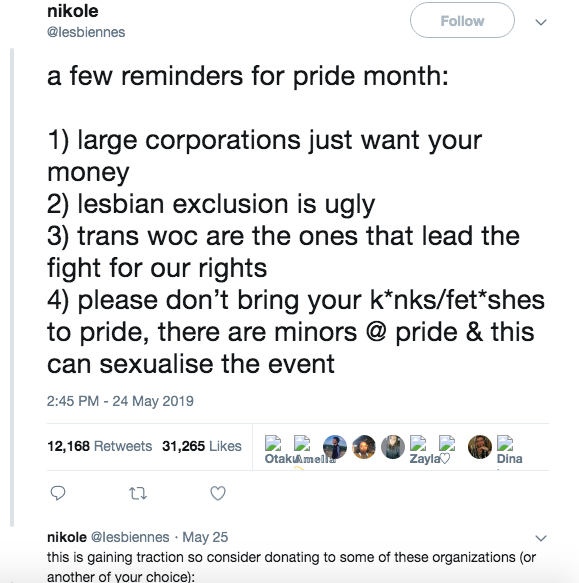
Each year, in the blazing sun of the Pride parade in Nelson, B.C., Pega Ren and her two young grandkids seek shade under their spinning rainbow parasols.
Ren, a semi-retired sex therapist, told HuffPost Canada the parasols were a magical find, and have come to symbolize the importance of this event for her family. Ren spoke joyfully of going to the dollar store, picking up all the rainbow ribbons and flags, decorating the roller skates and the stroller, and getting the costumes ready.
“I can’t imagine a safer place for families to bring children,” she said of Pride.
A resounding chorus of voices — from within the queer community and not — would agree with this general sentiment about Pride parades and kids. But in late May, one tweet turned it into a bigger conversation.
WATCH: This drag kid is amazing. Story continues below.
The post asked parade participants not to “sexualize” Pride and to leave their fetish and kink at home, for the sake of minors.
Anyone who has been to a parade has likely seen the procession of leather animal costumes, kinky costumes in every hue, and more skin than is normally exposed in public.
Although the post and account have since been deleted, the tweet got many people talking: How child-appropriate are Pride festivities? And why does this discussion hit a nerve for the LGBTQ+ community?
“At some level this has always been part of a much larger debate of what Pride is,” David Rayside, a retired politics and sexual diversity professor at the University of Toronto, told HuffPost Canada.
“Pride has always had a kind of outrageous edge to it. And should we alter that? It is not the Santa Claus parade, and it never was. It shouldn’t be. It can’t be.”

That said, Rayside added, not only is it important for parents to bring their kids, but “I’ve seen thousands of kids at Pride, and I’ve never seen anyone fuss about what they see there.”
In fact, many parents would fuss at the thought of not bringing kids to these events.
Pride is fun for kids, and an important cultural festival
“There is absolutely no reason not to take our kids to Pride — it’s a fun day, there are a lot of bubbles, rainbow streamers and enjoyable performances,” writer, educator, and publisher S. Bear Bergman told HuffPost Canada.
Plus, as queer parents, it’s one of their cultural festivals, added Bergman, who who attends Toronto Pride every year with his kids.
“It’s their right as queer spawn. And as a parent, I might want to take my kids to Pride, because they might be lesbian, gay, bi, trans, queer or two-spirit.”
Pride events are dynamic — with so many notes being played at once, a degree of dissonance can also be expected. No one knows this better than Parker Chapple, Executive Director of Calgary Pride.
As Canada’s fourth-largest and fastest growing Pride celebration, Calgary Pride works hard to be family-friendly, including events like Reading with Royalty and puppet-making. When asked how they go about balancing the needs of various segments of the community, Chapple (who uses they/ them pronouns) laughed.
“It’s hands-down one of the most challenging roles that any Pride director has,” they said.
Tensions are heightened this year
The tensions around who and what “belongs” at Pride are heightened this year, as the 50th anniversary of the Stonewall riots stands in contrast to the consumer culture that has become synonymous with the season. After the June 1969 raid of New York gay bar the Stonewall Inn, a series of uprisings began, and sparked the gay liberation movement. The first Pride march took place one year after those raids.
“As an activist, I’ve always been acutely aware of what the parade and the festival is rooted in,” Chapple said.
“And I’ve always passed that opportunity on to my children as a learning opportunity, so they can appreciate the work, the heartache, the celebration that our community put into gaining protection.”
WATCH: Remembering the Stonewall riots. Story continues below.
Politics have a prominent place in Pride, Rayside said, but “it is also about outrage,” a time when some in the community express this “in ways that confront normal sensibilities.”
The freedom to do so is embedded within LGBTQ+ culture and history. These expressions are the most colourful during the parade.
Bergman defended these elements and their right to exist at a kid-friendly event.
“First of all, nobody likes nakedness more than children,” Bergman said.
“On the list of things that I don’t want my children ever to be exposed to are: Compulsory heterosexuality, demonstrations of sexism, demonstrations of racism, demonstrations of ablism, violence. These are all way higher on the list than some homosexual’s tuchus.”
Pride is also a good learning opportunity
Putting on her sex therapist hat, Ren emphasized that Pride, from kink to nakedness, is an excellent opportunity for parents to do unbiased sex education. Bergman also pointed out that many children don’t even interpret most of what they’re seeing in a Pride parade as sexual, but rather as dress-up or fun.
“Children benefit from seeing people loving one another, from seeing diversity and inclusion. Children suffer from seeing violence and fear, hatred and divisiveness,” Ren said.
“We found and built our tribe at these gatherings.”
Also on HuffPost: